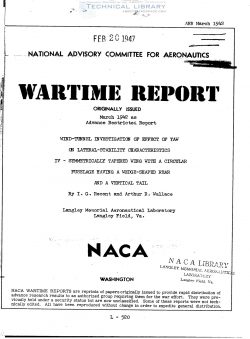naca-wr-l-520
- Version
- 142 Downloads
- 948.34 KB File Size
- 1 File Count
- April 2, 2017 Create Date
- April 2, 2017 Last Updated
Wind Tunnel Investigation of Effect of Yaw on Lateral Stability Characteristics - IV - Symmetrically Tapered Wing with a Circular Fuselage Having a Wedge-Shaped Rear and a Vertical Tail

By I. G; Recent and Arthur 3. Wallace
SUHKAR!
Combinations of an NAGA 23012 tapered wing and a cir-
cular fuselage having a wedge-shaped rear were tested in
the NAGA 7— by 10—foot wind tunnel to determine the effect
of wing—fuselage interference on the lateral—stability
characteristics. The model configurations represented a
high-wing. a midwing. and a low—wing moncplane. For each
configuratiou. tests were made with a partial—span split
flap neutral and deflected 60° and'with and without a ver-
tical tail. Tests of the fuselage alone and of the fuse—
lage with the vertical tail were also made.
_ The results are presented in the'fcrm bf increments
of the rate of change in the coefficients of-rolling mo-
ment. yawing moment. and lateral force with yaw caused by
wing—fuselage interference. The coefficients at high
.anglee of yaw for all model configurations are presented.
The data are compared with similar model combinations of
a tapered wing and circular fuselage with a pointed rear
-portion.
The interference effects on the combinations with
the wedge—rear fuselage were similar to those on the com-
binations with the circular fuselage: that-is. the inter-
ference reduced the effective dihedral of the lowrwing
model and increased the effective dihedral of the high—
wing model. and the vertical tail was more effective on
the low-wing combination than on the high-wing combina—
tione' . . . h
When the flap was neutral. the influence of inter-
ference on effective dihedral was greater for the
circular-fuselage combinations than for the wedge—rear-
fuselage combinations. When the flap was deflected' the
effect of the interference on the dihedral was more favor—
able for the wedge—rear—fuselage combinations than for
the circular—fuselage combinations. The directional sta—
bility of the model without tail with the wedge—rear
fuselage was more favorably affected by wing-fuselage
interference than the stability of those combinations
with the circular fuselage, but the interference had a
more favorable effect on the effectiveness of the verti—
cal tail of the circular—fuselage models than on that of
the wedge—rear-fuselage models.
At high angles of yaw the wedge-rear fuselage alone
was more stable directionally than the circular fuselage
alone.
INTRODUCTION
Data are available for evaluating the effect of the
aerodynamic interference between wing and fuselage and
between wing and vertical tail on the latera1~stability
characteristics for certain types of model. The effects
of interference on the characteristics of four types of
wing having a partial—span split flap, both neutral and
deflected, in combination with a circular fuselage are
given in references 1 and 2. A comparison of a circular
and an elliptical fuselage is shown in reference 2. The
effect of the vertical pasition of the wing on the fuse—
lage is given in references 1 and 2. and the effect of
the longitudinal position of the wing on the fuselage is
given in reference 3.
It was thought desirable to extend this investiga—
tion by tests of a fusela e of circular cross section but
tapering to a knife edge wedge rear) at the rear, because
this shape is representative of a commonly used fuselage.
Tests (reference 4) have shown that this type of fuselage
is more stable, directionally, than a circular fuselage
at large angles of yaw.
The present report gives the results of tests of a
wedge—rear fuselage in combination with a wing at three
vertical pesitions on the fuselage. Each combination was
tested with and without a vertical tail and with and with—
out a partial—span split flap deflected 60°.
| File | Action |
|---|---|
| naca-wr-l-520 Wind Tunnel Investigation of Effect of Yaw on Lateral Stability Characteristics - IV - Symmetrically Tapered Wing with.pdf | Download |

Comment On This Post